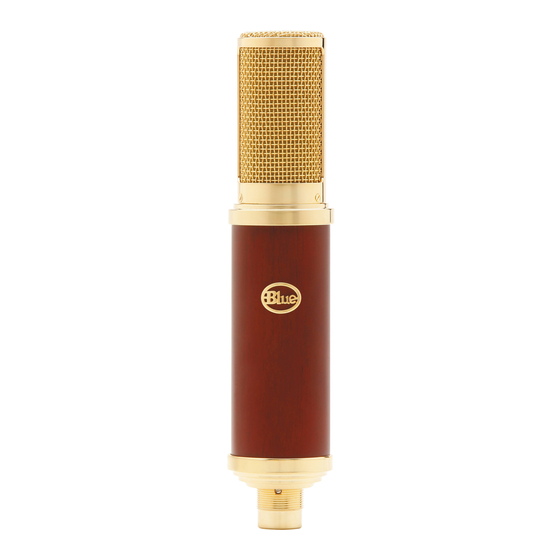Blue Blueberry Gebruikershandleiding - Pagina 4
Blader online of download pdf Gebruikershandleiding voor {categorie_naam} Blue Blueberry. Blue Blueberry 4 pagina's. Phantom powered ribbon microphone
Ook voor Blue Blueberry: Gebruikershandleiding (4 pagina's)

ence that enables the most delicate sounds to cut
through a mix, even at very low levels.
The microphone's MZ02 solid-state electronics are
based on a Class A, fully discrete circuit. In plain
English, this means that the sound which arrives at
the diaphragm is transduced (converted to electrical
energy) as accurately as possible, with no integrated
circuits (a.k.a. "IC's") in the signal path. To get the
most out of this, or any quality microphone, it is
essential to pair it with a good microphone pre-
amplifier. Most professional recordists prefer to
have outboard preamps on hand, and will choose
solid-state or vacuum tube models based on their
unique characteristics. To maintain the integrity of
your signal, use the Blueberry high-definition mic
cable going into the mic preamp. And, whenever
possible, connect the mic preamp output directly to
your recorder or A/D converter, bypassing the mixing
board and any unnecessary components.
For mounting the microphone on a stand, a recessed,
threaded socket is built into the Blueberry body,
next to the XLR output jack. Optional Series One or
Series Two shockmounts offer alternative mounting
systems to enhance positioning and isolate the
microphone body from low frequency vibrations
conducted through the stand. The Series One cradle
mount includes a mounting bracket which also
The Blueberry with optional shockmounts and W1
POP Filter
functions as a base for the W1 wire mesh pop filter;
to fit the Blueberry into this bracket you must first
remove the four knurled nuts on the side of the
microphone. If a pop filter is not required, the
Series Two yoke mount is recommended. Its elastic
bands attach easily to the knurled nuts on the side
of the microphone.
Whether you are using the microphone on its own,
or with a shockmount, you may find it easiest to 1)
loosen the boom stand arm or threaded end of the
mic stand, 2) grasp the mic or shockmount assembly
Blueberry Capsule Frequency Response
0
-4
-8
-12
20
30
50
70
100
200
300
500
Frequency (Hz)
This frequency chart of the Blueberry capsule is only a start. It gives the recordist a basis of the
sound provided. How the microphone reacts in a particular application will differ greatly because of
many variables. Room acoustics, distance from sound source (proximity), tuning of the instrument
and microphone cabling are only a few of the interacting issues. For an artist or engineer, how the
microphones are used creates the basis of the sound.
in one hand, and 3) screw the mic stand threads into
the appropriate mount, without over-tightening. This
procedure will assure that the elastic shockmount
bands stay in place, and eliminates any possibility
of damage to the mic. The angle of the swivel mount
can be adjusted with the large thumbscrew.
The Blueberry requires 48 volt phantom power, which
is provided by most mic preamps, mixing consoles,
or separate phantom power supplies. It is important
to note that some units, though rated at 48 volts,
may supply insufficient or unstable phantom power,
which can result in distortion and/or degraded per-
formance when used with this microphone.
To avoid damage to audio components when connect-
ing phantom power, follow this simple procedure:
1) turn down the mic preamp gain, headphones, and
your studio monitors, 2) connect microphone cable
to the Blueberry and microphone input jack, 3) turn
on phantom power, 4) turn up the mic preamp gain,
etc. To disconnect or re-route the Blueberry, 1) turn
down the mic preamp gain, headphones, and your
studio monitors, 2) turn off phantom power and wait
10 seconds before disconnecting the mic.
Once the Blueberry is on the stand and powered up,
make sure that the active, on-axis side of the capsule
(the side of the mic with the BLUE logo) is facing the
desired source. The Blueberry is a cardioid microphone,
and is designed to reject off-axis sound arriving at
the back of the capsule. And now, here are some
recording tips that will allow you to get the most
out of the Blueberry!!
Vocals
Here's a little-known secret—vocalists love singing
into unique and impressive mics. And in addition to
its good looks, the Blueberry was developed especially
to enhance the airiness and detail in any voice,
while diminishing the proximity-induced lows which
can cloud a mix or produce compression artifacts.
Put it in front of any singer and you are guaranteed
to get a 110% inspired performance that sits per-
fectly in the mix with little or no additional equal-
ization. The Blueberry is also an outstanding choice
for narration and voiceover work.
800
2K
3K
5K
7K
10K
22.05K
